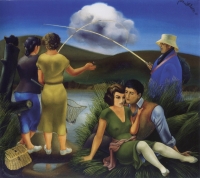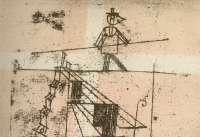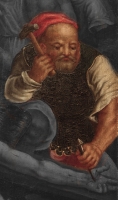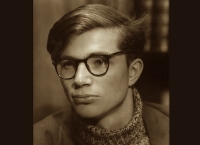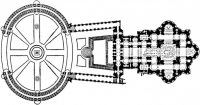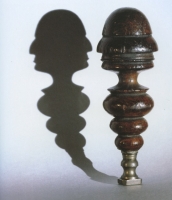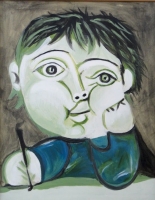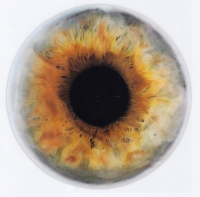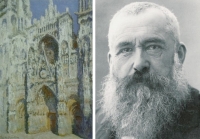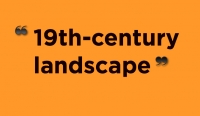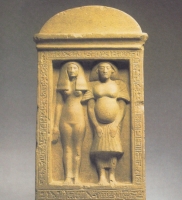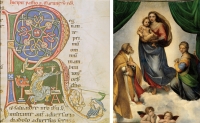25 Mar 2015
Wisdom, Art and a Cat
I'm always on the lookout for written expressions of the basic ideas about visual art conveyed on EPPH. Here's one that backs up the concept that art and the practice of it leads to wisdom. A beautiful old Irish poem, now known as Pangur Bán af
20 Mar 2015
Whose God is on the dollar bill?
Art is too often seen as a literal representation of the artist's own small, physical world. The idea that it uses metaphoric language to express much larger, eternal truths shared by all mankind is seldom realized. The same happens with the dol
06 Mar 2015
C.S. Lewis on a Poetic Method
The late Sidney Geist, a sculptor and controversial interpreter of Cézanne's art, invited me about 12 years ago to come and see him at his studio in Manhattan. I had spent the past year studying everything about Edouard Manet and was excited to
26 Feb 2015
Art in Search of Self-Knowledge
One of the great shibboleths of art history is that High Renaissance masters depicted the exterior world. Few, of course, doubt that landscapes and portraits represent exterior nature. EPPH, on the other hand, argues that all scenes in art are i
26 Feb 2015 | 2 Comments
Picasso on EPPH
At the small but excellent Museu Picasso in Barcelona, a repository for much of Picasso's early work and the complete series of paintings on Las Meninas, they sell a pencil (above). Draw your own conclusions. No comment.
05 Feb 2015 | 2 Comments
Do you draw your own features unintentionally?
Readers, especially artists, I could do with some help. Do you reproduce your own features without meaning to? Do you have examples? Many initial viewers, usually those who can draw, ask me whether artists fused faces (see above) intentionally o
16 Jan 2015 | 2 Comments
The Centrality of Tools
Art sometimes seems like a meditation on the brush. Certainly visual metaphors for art's tools abound from, say, Edouard Manet’s early Boy with a Sword (in effect he holds a giant paintbrush, see explanation) to Diego Velazquez’s Portrait
11 Jan 2015
Hans Memling and Cubism
Every time I look at this Portrait of a Man by Hans Memling I feel a little sick. I’m serious. It makes me slightly nauseous. Perhaps Walter Pater, the 19th-century art historian, felt similarly about the Mona Lisa. He described her as a weirdo
29 Dec 2014
For how long have we read the Bible literally?
I learnt an astonishing fact today.1 The habit of reading the Bible as though it is historically true (especially the New Testament) started during the Protestant Reformation which began in 1517 and lasted more than a century. For the first 1,50
10 Dec 2014 | 1 Comments
Van Eyck’s Alpha and Omega
The world seems to work in our favor. Things happen which I used to call coincidence but which, in hindsight, are often far too fortuitous to be chance. Carl Jung described such events, at least the unusually important ones, as sy
02 Dec 2014
How Portraiture Causes Blindness
Specialisation has crippled art history, blinding its practitioners to what is common. For over six years EPPH has been arguing that many portraits by major artists are fusions of the artist's facial features with the sitter's. They were never i
08 Nov 2014
3 Practical Ways to Understand Art
How can museum visitors and art lovers interpret art for themselves without having the specialized knowledge of experts? It is easier than you think and within the grasp of many. The key is not in books but experience. And that would have been tru
30 Oct 2014
An Artist’s Path to Certainty
How does a great artist know he is on the right track before being recognized as canonical? Van Gogh, for example, knew his own importance despite commercial and critical failure; Picasso was convinced at a very young age. The answer, I believe,
24 Oct 2014
Science, Religion and Art: Einstein on the Inner Tradition
Perhaps the most difficult part of understanding art is the Inner Tradition, the path that links not only all the world’s major religions but science, literature and music too. Religious believers strongly attached to a particular creed are un
17 Oct 2014
Brushing up on the Painter’s Sword
The mind of an artist is poetic so, if you want to understand painting and sculpture, read poets. Their literary metaphors are the artist’s visual ones. However, beware: poets understand visual art no better than most people. Emile Zola, Charl
06 Oct 2014 | 1 Comments
Dürer, Titian, Art and Blasphemy
For those who have trouble - I certainly did - understanding how artists like Dürer (top) and Titian (below) could have portrayed themselves as Christ, here is a poem attributed to an 11th-century spiritual master of the Greek Orthodox Church
24 Sep 2014 | 2 Comments
Reading Art: Manet, Picasso and Alfonso Ponce de Leon
My vision, like most people’s, is often cloudy which is why when the sun breaks and I gain some understanding, I get excited. You must excuse me. It may sometimes seem as if no-one before me has made similar observations. After all, all my ent
27 Aug 2014
God help me!
Failure can scare anyone, let alone artists like Paul Klee who sometimes imagine that they are performing at such a high level that the consequences of a bad showing will be free fall. Yet, like tightrope walkers, they have practiced their craft
20 Aug 2014
The Craftsman’s Christ
This is a scene by an unknown 16th-century artist, probably Flemish, at a time when artisanal effort was admired not just for the perfection of the end-product but for the artisan’s closely-guarded knowledge of materials. Wood, stone, minerals,
28 Jul 2014 | 4 Comments
Ego’s Poetic Powers
EPPH has long argued that artists mute their ego to gain access to poetic depths. Yet in the passage below Colin Wilson, the English philosopher and novelist who died last year, describes a more balanced understanding in which poets identify wit
23 Jul 2014
Key to Meaning in Architecture
Symbols, as explained here about painting and sculpture, can be concealed at many levels, some so deeply that only initiates would notice them. Who other than an architect could possibly have seen what Bernini did to St. Peter’s in Rome w
19 Jul 2014 | 1 Comments
How many features does a face need?
How much information do we need to recognize a face? Astonishingly little. Here George Washington’s can be recognized in the handle of a wooden seal (c.1810). This explains, perhaps, how artists can continuously convey their features in other
13 Jul 2014 | 4 Comments
What users are saying about EPPH
EPPH gets all sorts of readers yet of those who return, there is a definite type. How do we know? The vast majority of comments are complimentary (96%); many of you seem to respond in the same way and you are quite likely to be an artist too. Th
05 Jul 2014 | 1 Comments
Why art’s meaning repeats
There is never any new content in art [see definition below].1 Art’s meaning is true. Truth is constant. Thus, it must always be true. And it must always have been true, at least since the development of mankind. So, if art expresses fundament
25 Jun 2014 | 2 Comments
Is self-representation self-centered?
(On vacation. A re-post from last summer)
The practical and philosophical issue of whether figures in art depict the artist or the apparent character is well expressed by two different translations of the same text in a Upanishad. The p
13 May 2014
Giacometti on his Sitters’ Inner Being
So much of the poetic method in art remains a closely-held secret. Like initiates in a mystery religion, great artists have long had a common understanding that what they prize in their creative process should not be shared with the unappreciati
09 May 2014
Naming Names
Names limit. We need them as shorthand, to avoid explaining everything from scratch. But they deceive, confuse and blind. I'm talking about names in everday life and how, once used, they pigeon-hole the person, the object, the idea or whatever i
01 May 2014 | 1 Comments
An Intriguing Self-portrait, c.1345 BC
One of the earliest surviving self-portraits from antiquity is that of Bak, chief sculptor to the Egyptian pharaoh Akhenaten. It is beautifully preserved in Berlin (above) and is very intriguing given Western art history’s traditional descript
23 Apr 2014
Raphael, a Brother, and an Initial Idea
Art, according to EPPH, is esoteric, a visual primer on the Inner Tradition created by women and men every bit as spiritual as a robed monk, often more so. Indeed in the Middle Ages most artists were clerics or monks working in the scriptorium o
14 Apr 2014
Joseph Cornell gives birth to a box…
Birthing, physical birth, is one of poetry and art’s most powerful metaphors used for many centuries, perhaps ever since art first appeared. It plays on the relationship between sexual conception and mental conception while often conveying that
The EPPH Blog features issues and commentary.
















